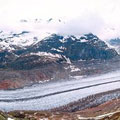Climate change-driven glacial melt is causing landslides in alpine regions. Data from the Sentinel-1 satellite mission are being inserted into a new cloud computing system to monitor such hazards globally.
Climate change-driven glacial melt is causing landslides in alpine regions. Data from the Sentinel-1 satellite mission are being inserted into a new cloud computing system to monitor such hazards globally.
The Aletsch Glacier, the largest in the Alps, is experiencing an average retreat of about 50 m a year. The adjacent rocks that were previously constrained by the ice mass are progressively being released, generating slope instabilities. For this reason, the Aletsch region is a unique place where scientists can investigate how changes in glaciers affect the long- and short-term evolution of rock slope stability.
To monitor the progressive changes occurring throughout a 2 sq km area southeast of the glacier - called the Moosfluh slope - the Chair of Engineering Geology at the Swiss Federal Institute of Technology in Zurich (ETHZ) installed ground-based instruments in 2013.
Between September and October 2016, Moosfluh experienced an abnormal acceleration. The deformation generated several deep cracks and rock failures, hindering access to hiking paths visited by tourists, and affecting a cable car station located near the crest of the slope.
To investigate the extent of the landslide further, radar images from the Copernicus Sentinel-1 satellite mission over August to November 2016 were analysed with the ESA's Geohazards Exploitation Platform – or GEP – to produce a velocity map of the unstable area.
